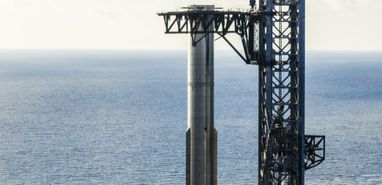
SpaceX continues to prepare for Starship Flight 5 in Texas as it awaits FAA approval, expected by late November at the earliest. After testing the tower’s catch arms recently, the company just lifted the 232-foot-tall Super Heavy booster at the launch tower to simulate a catch attempt.
The tower catch is essential for Starship’s rapid reusability, and this marks the first time SpaceX has lifted the massive booster to the full height needed for a test catch.
SpaceX Accelerates Preparations To Test Starship’s Riskiest Flight Profile Element
Footage from local media showed SpaceX lifting the tower arms to catch height, conducting multiple tests to open and close them as part of Starship Flight 5 preparations. These intermittent tests began following Starship’s fourth test flight earlier this year. Initially, SpaceX used smaller prototypes to calculate the distance the arms must cover to catch the booster during a rapid closing.
Since then, SpaceX has focused on testing rocket engines and upper-stage spacecraft for Starship Flight 6. For Flight 5, SpaceX has also completely upgraded the heat shield of the Starship, which consists of thousands of protective tiles. Now, while awaiting FAA approval, SpaceX has lifted the Super Heavy booster to the top of the launch tower, simulating the position it would be in for a catch attempt during Flight 5.
Images from the event reveal the absence of the interstage booster ring atop the Super Heavy, which is expected, as SpaceX plans to jettison the ring into the ocean before the booster prepares for a soft landing. The ring is a relatively new addition to Starship’s design, introduced after Flight 1, where the first and second stages failed to separate properly.
Testing the Tower’s Catch Arms and Preparing for Future Flights

By lifting the booster to the catch height, SpaceX can verify the strength of the tower’s arms, clearing them for future flight operations. These arms are crucial not only for catching the booster but also for stacking the Starship on top of the booster pre-launch. SpaceX’s long-term goal of rapid reusability envisions refurbishing the booster on the pad and then quickly stacking the Starship for another launch.
With this latest tower test complete, SpaceX might soon move the second-stage Starship to the pad and stack it on top of the booster. However, given that an upgraded launch license is required to approve the catch attempt and a new splashdown zone for the booster ring needs to be defined, SpaceX can only make limited additional progress until these approvals are granted.
By Andrej Kovacevic
Updated on 9th March 2025